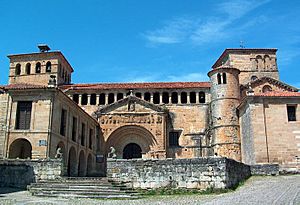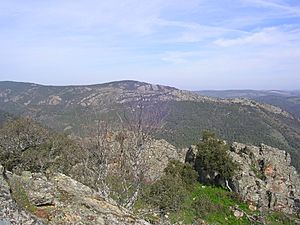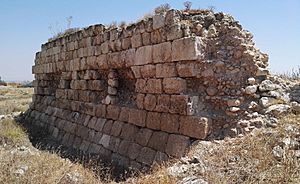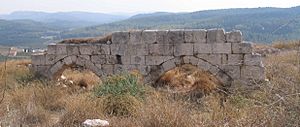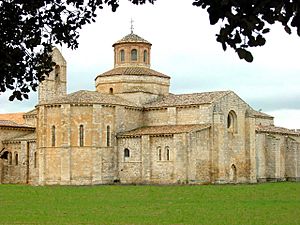Rodrigo González de Lara facts for kids
Rodrigo González de Lara was an important nobleman from Castile who lived from about 1078 to 1143. He belonged to the powerful House of Lara.
Early in his life, he governed a part of Asturias, a region in northern Spain. He was very loyal to Queen Urraca, who ruled from 1109 to 1126. During her reign, he married the queen's half-sister and controlled a large area of what was once the County of Castile.
Later, Rodrigo and his older brother, Pedro González, were leaders who opposed King Alfonso VII when he first became king (1126–1157). Rodrigo even led a rebellion in 1130 and was sent away from the kingdom in 1137.
He was a key figure in the Reconquista, which was the long period when Christian kingdoms in Spain fought to take back land from Muslim rulers. A book from that time, the Chronica Adefonsi imperatoris, tells us a lot about his actions. Rodrigo also traveled far and took part in military actions in the Crusader states, which were Christian kingdoms in the Middle East. He traveled a lot across Spain but spent his last days in Palestine.
Contents
Early Life and Service (1078–1112)
Rodrigo was the son of Gonzalo Núñez de Lara and Godo Núñez. His family was not very rich or powerful at first.
There was a Rodrigo González who was the alférez (standard-bearer, a high military position) for King Alfonso VI between 1078 and 1081. Some historians think this might have been Rodrigo González de Lara. If so, he would have been quite old when he died. This alférez also signed an important document for the famous knight El Cid in 1080 or 1081.
Governing Regions (1112–1130)
Rodrigo González de Lara first appears in records as governing a territory called a tenencia in 1112. He was in charge of several areas in the Cantabrian region, including Asturias de Santillana. By 1119, he also ruled Trasmiera. Later, his control spread to Aguilar de Campoo. Around this time, he also started governing parts of "Castile," likely Old Castile.
By 1121, Rodrigo had become a count, which was a very important title. In 1122, he gave a gift to the Santa María de Piasca monastery.
Before 1122, Rodrigo married Sancha, who was a daughter of King Alfonso VI. They had three daughters: Elvira, Sancha, and Urraca.
Rodrigo approved many royal documents during Queen Urraca's rule. He held a lot of power in the Kingdom of León during the last six years of her reign, which was a peaceful time. He governed areas like Liébana, Nángulo, Piedras Negras, and Tierra de Campos. By 1125, he also ruled Pernía. After his wife Sancha died, their youngest daughter, Urraca, was cared for by the king's sister, Sancha Raimúndez.
Rebellion Against Alfonso VII (1130–1131)
After Queen Urraca died in 1126, her son Alfonso VII became king. However, the royal fortress in León refused to accept him. Instead, they preferred Pedro González (Rodrigo's brother) and Rodrigo. The Chronica Adefonsi says these brothers "preferred war rather than peace with the King."
Eventually, Pedro and Rodrigo were forced to submit to King Alfonso VII, but they did not do so willingly. They seemed to prefer supporting the King of Aragón.
In 1130, Rodrigo rebelled against King Alfonso VII. This rebellion seemed aimed at putting Rodrigo's nephew, Fernando Pérez de Lara (son of Pedro González and Queen Urraca), on the throne. The King of Aragon supported this rebellion.
While Pedro and another relative took the city of Palencia, Rodrigo started his fight in Asturias de Santillana. King Alfonso quickly dealt with the other rebels. He then turned to Asturias, where he "captured their fortified castles, set fire to their fields and hacked down their trees and vineyards."
Rodrigo was forced to ask for peace. He met the king by the Pisuerga River. During the meeting, the king became so angry with Rodrigo's "disrespectful remarks" that he grabbed him, and they both fell from their horses. Rodrigo's men fled, and he was captured.
Rodrigo lost all his castles and territories. Asturias was then given to Rodrigo Gómez. After being released, Rodrigo returned to admit his mistakes and ask for mercy. By the end of 1131, he was forgiven and made the alcaide (governor) of Toledo.
Frontier Rule (1131–1137)
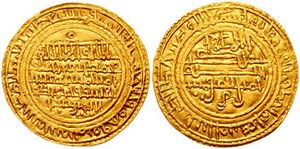
Rodrigo was a skilled military leader against the Moors (Muslims in Spain). The Chronica Adefonsi mentions he "waged numerous wars against the Moors. He killed many and took many prisoners. He also carried away large quantities of booty from their lands." The book says that only a small part of his military actions were recorded.
Rodrigo governed Toledo from 1132 to 1136 and also Segovia in 1133. The Chronica Adefonsi states that Alfonso "entrusted Toledo to him and extensive territories on the frontier and in Castile." He was also made "commander of all troops in Toledo and leader of Extremadura."
In June 1132, Rodrigo gathered soldiers from Ávila, Segovia, Toledo, and other cities. He led them on a raid into Muslim territory, down the Guadalquivir valley, causing damage around Seville. He took many captives and a lot of treasure. The Almoravid governor of Seville, Umar, gathered a large army and fought Rodrigo in a big battle.
Rodrigo organized his army carefully. He divided his foot soldiers into archers and slingers. He put his bravest men at the front. The militia (citizen soldiers) of Ávila formed the second line, and the militia of Segovia formed the third. The Toledo militia and other troops were kept at the back as a reserve, under Rodrigo's direct command, to help where needed.
Umar was captured and killed. This battle was so important that it was written about in three different historical accounts. The author of the Chronica compared it to a biblical battle.
In May 1133, Rodrigo commanded half of the royal army marching from Toledo. The army split because there wasn't enough water or food for the animals. Rodrigo led his forces through the Despeñaperros Pass. The armies traveled through empty land for 15 days before reaching an enemy castle. They then followed the same route as the previous year, going to Seville, then to Jerez de la Frontera (which was looted), and Cádiz (whose countryside was attacked). The army returned to Toledo by late summer with a huge amount of animals and treasure.
By July 1135, Rodrigo had married a second time to Estefanía. She was the daughter of Ermengol V of Urgell and the widow of another nobleman. Estefanía had two sons with Rodrigo: Pedro and Rodrigo.
Exile and Travels (1137–1143)
In 1137, for reasons unknown, Rodrigo lost the king's favor and was sent into exile. He willingly gave up Toledo and his other territories to the king. He decided to turn his exile into a pilgrimage (a religious journey). He traveled to Jerusalem and fought against Muslims in the Holy Land for two years.
He is said to have built a castle called Toron, facing Ascalon, which was then controlled by Muslims. The Chronica says he filled it with knights, soldiers, and supplies, and then gave it to the Knights Templar, a military religious order. Historians have tried to figure out exactly which castle this was, with some suggesting it might be the ruins at Summil. In 1137 or 1138, a church official named Rorgo Fretellus dedicated his book, Description of the Holy Places, to Rodrigo.
Rodrigo returned to Spain in 1139, traveling through the Adriatic Sea and Italy. Since he couldn't return to Castile, he stayed at different courts in eastern Spain. He served Raymond Berengar IV of Barcelona for a time, who made him lord of Huesca and Jaca. He later served García Ramírez of Navarre and then the Muslim governor of Valencia. The Chronica Adefonsi says that while in Valencia, he became ill.
He did briefly return to Castile in 1141. He eventually went to Urgell, where in 1143 he witnessed the will of his brother-in-law, Count Ermengol VI. His daughter Elvira had likely died by then. Sometime in or after 1143, he returned to the Holy Land, where he died.
Shortly before Rodrigo's death, his wife Estefanía founded a Cistercian monastery at Valbuena de Duero in 1143. Their sons did not achieve as high a rank in the kingdom as their father had.
See also
 In Spanish: Rodrigo González de Lara para niños
In Spanish: Rodrigo González de Lara para niños


